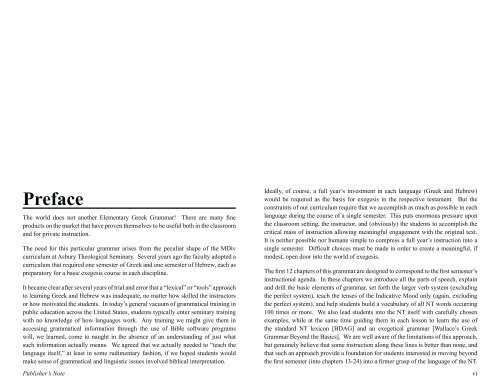Elementary New Testament Greek, 2014a
Elementary New Testament Greek, 2014a
Elementary New Testament Greek, 2014a
Create successful ePaper yourself
Turn your PDF publications into a flip-book with our unique Google optimized e-Paper software.
Preface<br />
The world does not another <strong>Elementary</strong> <strong>Greek</strong> Grammar There are many ne<br />
products on the market that have proven themselves to be useful both in the classroom<br />
and for private instruction.<br />
The need for this particular grammar arises from the peculiar shape of the MDiv<br />
curriculum at Asbury Theological Seminary. Several years ago the faculty adopted a<br />
curriculum that required one semester of <strong>Greek</strong> and one semester of Hebrew, each as<br />
preparatory for a basic exegesis course in each discipline.<br />
It became clear after several years of trial and error that a “lexical” or “tools” approach<br />
to learning <strong>Greek</strong> and Hebrew was inadequate, no matter how skilled the instructors<br />
or how motivated the students. In today’s general vacuum of grammatical training in<br />
public education across the United States, students typically enter seminary training<br />
with no knowledge of how languages work. Any training we might give them in<br />
accessing grammatical information through the use of Bible software programs<br />
will, we learned, come to naught in the absence of an understanding of just what<br />
such information actually means. We agreed that we actually needed to “teach the<br />
language itself,” at least in some rudimentary fashion, if we hoped students would<br />
make sense of grammatical and linguistic issues involved biblical interpretation.<br />
Publisher’s Note<br />
Ideally, of course, a full year’s investment in each language (<strong>Greek</strong> and Hebrew)<br />
would be required as the basis for exegesis in the respective testament. But the<br />
constraints of our curriculum require that we accomplish as much as possible in each<br />
language during the course of a single semester. This puts enormous pressure upon<br />
the classroom setting, the instructor, and (obviously) the students to accomplish the<br />
critical mass of instruction allowing meaningful engagement with the original text.<br />
It is neither possible nor humane simple to compress a full year’s instruction into a<br />
single semester. Difcult choices must be made in order to create a meaningful, if<br />
modest, open door into the world of exegesis.<br />
The rst 12 chapters of this grammar are designed to correspond to the rst semester’s<br />
instructional agenda. In these chapters we introduce all the parts of speech, explain<br />
and drill the basic elements of grammar, set forth the larger verb system (excluding<br />
the perfect system), teach the tenses of the Indicative Mood only (again, excluding<br />
the perfect system), and help students build a vocabulary of all NT words occurring<br />
100 times or more. We also lead students into the NT itself with carefully chosen<br />
examples, while at the same time guiding them in each lesson to learn the use of<br />
the standard NT lexicon [BDAG] and an exegetical grammar [Wallace’s <strong>Greek</strong><br />
Grammar Beyond the Basics]. We are well aware of the limitations of this approach,<br />
but genuinely believe that some instruction along these lines is better than none, and<br />
that such an approach provide a foundation for students interested in moving beyond<br />
the rst semester (into chapters 13-24) into a rmer grasp of the language of the NT.<br />
vi


















